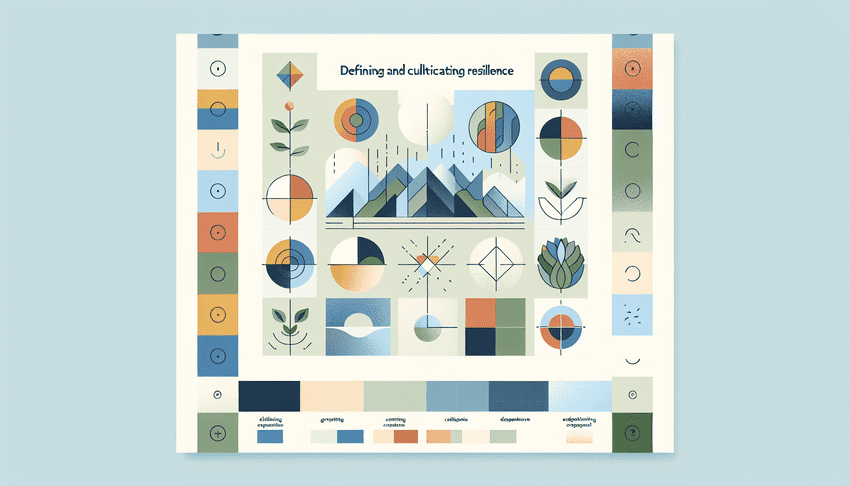Table of Contents
Defining and Cultivating Resilience

Understanding Resilience as a Psychological Construct
Resilience is often perceived as the mental steel that forges an individual’s capacity to rebound from setbacks, standing taller than ever before. The concept transcends the simplistic understanding of recovery; it embodies the intricate dance between human adaptability, perseverance, and the unfailing attitude of optimism that collectively empower one to surpass the hurdles of adversity.
- Adaptability: Change is the only constant, as the old adage goes. But in the realm of resilience, the capacity to pivot in the face of change is critical. This means being agile in thought and action, recalibrating one’s mindset, and finding new avenues to strive towards success.
- Perseverance: Resilience is deeply rooted in determination. The tenacious grip on one’s goals in the eye of the storm is what forges the steel of resilience. It’s about pressing on when the easy route is to surrender.
- Optimism: The resilient mind is one that is persistently hopeful, a mind that sees the silver lining even when the skies are grey. This is not blind positivity, but a strategic approach to problem-solving that involves expecting favorable outcomes and working towards them.
Adaptability in Resiliency
Take, for instance, the tale of a small business owner struck by a natural disaster. Instead of letting defeat set in, the owner used adaptability as a stepping stone; she pivoted her business model towards online services, reaching out to a broader customer base and reviving her trade. This act of evolving with the circumstances is a hallmark of resilience.
Perseverance Powers Through
Consider the student who, faced with academic failure, refuses to let it define his journey. With each setback, he fine-tunes his strategies, studies harder, and eventually achieves his desired results. His resilience lies in his refusal to give up, harnessing the power of perseverance as fuel.
Optimistic Outlook as a Resilience Multiplier
Finally, consider the individuals who, despite receiving a daunting medical diagnosis, chose to approach their situation with optimism. This outlook can lead to a proactive stance in seeking treatment, fostering a supportive community network, and maintaining a focus on wellness rather than illness. It is their optimism that magnifies their resilience, giving them the strength to face their battles head-on.
In closing, resilience is not merely about survival; it is about thriving. It weaves together the fabric of adaptability, the grit of perseverance, and the brightness of optimism to create a psychological construct that can be cultivated and harnessed. By embracing and nurturing these components, individuals can fortify their resilience and navigate the complexities of life with grace and strength.
Building a Strong Support Network
Building a strong support network is one of the most vital life coping strategies one can cultivate. When it comes to Personal Resilience Development, having a network of supportive relationships enables us to harness emotional strength and facilitates Overcoming Challenges. Our social connections offer more than just companionship; they provide the empathy, perspective, and resources we need for Resilience Techniques to truly thrive.
These connections play a crucial role in buffering us against adversity. Consider the case of Maria, a middle-aged woman facing the sudden loss of her job. Overwhelmed by uncertainty and the practicalities of job-hunting, it was her close-knit group of former colleagues and family members who rallied around her, offering emotional support and networking opportunities. It’s through these tangible acts of support that personal networks become a lifeline, helping individuals navigate through rough patches.
Furthermore, research in Positive Psychology and Happiness demonstrates that individuals with solid social support tend to exhibit better mental health than those who lack such networks. A robust support system can mitigate the effects of stress and contribute to quicker recovery from illness. When Jim was recovering from a major surgery, it was the regular visits and assistance from friends and neighbors that significantly lifted his spirits and aided in his physical recovery. This support played a vital role in preserving his Emotional Strength.
Beyond individual anecdotes, studies have consistently shown that the presence of supportive relationships contributes to greater longevity, reduced stress levels, and improved overall well-being. In cultivating these relationships, we are essentially building an emotional safety net. This doesn’t mean solely relying on others; it’s also about contributing to the mutual welfare of the network. It’s a reciprocal dynamic, where providing support can be just as beneficial as receiving it.
- Actively listen and offer empathy when someone shares their struggles.
- Extend help without being asked when you notice someone could use a hand.
- Create and participate in community groups that provide shared support and interests.
Taking these steps not only enriches our support network but also embeds us within a community of care, fostering a sense of belonging and collective resilience. In turn, this network becomes an invaluable asset for Overcoming Challenges and ensures that during tough times, none of us has to stand alone.
Enhancing Well-Being and Happiness

The Role of Positive Emotions in Resilience
Resilience, often defined as the ability to bounce back from adversity, is a critical factor in the pursuit of happiness and well-being. In exploring the elements of Positive Psychology and Happiness, we cannot overlook the profound influence of positive emotions on resilience. This interconnection forms the bedrock of the broaden-and-build theory, an idea introduced by psychologist Barbara Fredrickson which has reshaped our understanding of emotional prosperity.
The Broaden-and-Build Theory: Expanding Personal Resources
Fredrickson’s theory posits that experiencing positive emotions broadens an individual’s momentary thought-action repertoire, which in turn builds their enduring personal resources. For instance, joy sparks the urge to play, interest fuels the desire to explore, and contentment fosters an environment where one can savor experiences and integrate them into their sense of self. These immediate behaviors open an array of pathways to new possibilities which is eloquently termed as ‘broadening’.
But positive emotions do more than expand our awareness—they also nurture our resilience by bolstering our psychological resources. Each instance of broadening serves as a block in constructing a more durable foundation of resilience. Over time, positivity fosters an upward spiral, with resilience reinforcing our ability to experience positive emotions and vice versa.
Evidence for the Positive Emotions-Resilience Link
Empirical research stands firmly behind the bond between positive emotions and resilience. Studies show that individuals with higher baseline levels of positive emotions remain more resilient in the face of stress and recover more aptly from traumatic events. These individuals display not just mere coping, but often a phenomenon called post-traumatic growth, where they emerge from adversity with heightened personal strength and a greater appreciation for life.
Resilience, however, isn’t just a byproduct of innate character traits. It can be cultivated through the intentional practice of generating positive emotions. Engaging with life’s simple pleasures, nurturing relationships, practicing gratitude, and restructuring cognitions about adverse situations are all strategies that can invigorate the beneficial cycle of positive emotions building resilience.
Cultivating Positive Emotions in Everyday Life
So how can one weave the creation of positive emotions into the fabric of daily existence to foster resilience? Here are some practical suggestions to consider:
- Gratitude Journaling: Once a day, write down three things you’re grateful for. It heightens your attention to positive experiences.
- Mindfulness: Engage in mindfulness practices such as meditation or deep-breathing exercises. These activities are conducive to both relaxation and an increased awareness of the present moment, allowing enjoyment of the small delights of life.
- Acts of Kindness: Perform random acts of kindness. Whether it’s helping a neighbor or complimenting a stranger, such acts lead to a warm glow of positive emotions.
Through such practices, resilience does not stay a passive quality but rather an active state that we can nurture and grow. This perspective gives us agency in our pursuit of happiness, where resilience serves as both a shield and a catalyst for flourishing.
In conclusion, embracing and cultivating positive emotions is a scientifically supported strategy to enhance our resilience. Whether through the joy of playing with a pet, the serenity found in nature, or the pride of personal accomplishments—activating these emotions can broaden our cognitive processes and contribute to a resilient mindset, preparing us for the ebbs and flows of life with strength and positivity. Resilience, therefore, is not just the end game—it is a journey rich with positive emotions that ultimately leads to a more fulfilled and happy existence.
Emotional Intelligence and Its Influence on Happiness
Resilience stands at the heart of Positive Psychology, shaping our capacity to thrive in the face of adversity. It is not just a buzzword; it’s the psychological muscle flexed when challenges arise. This ability to bounce back from stress, trauma, or tragedy is essential for achieving and maintaining Happiness. As we explore the intricate dance between Emotional Intelligence and Happiness, we uncover why learning to harness Emotional Intelligence is pivotal for bolstering our Resilience.
Understanding Emotional Intelligence and its Connection to Well-being
Emotional Intelligence (EI) is the ability to understand, use, and manage our emotions in positive ways to relieve stress, communicate effectively, empathize with others, overcome challenges, and defuse conflict. It extends beyond merely recognizing one’s emotions—it involves a deeper comprehension and management of those emotions for improved well-being.
The concept of Emotional Intelligence has revolutionized our approach to personal development. Various studies have underscored its significance as a predictor for life satisfaction, surpassing even traditional measures such as IQ. By developing a higher EI, individuals are better equipped to perceive and interpret their emotions and those of others, paving the way for improved social interactions and deeper connections.
Research has consistently found that those with higher Emotional Intelligence are more resilient. They display a unique ability to navigate the emotional complexities of life with grace and maintain a positive outlook despite setbacks. This makes them happier, not just in fleeting moments, but as an enduring state of being.
Strategies to Enhance Emotional Intelligence
Improving your Emotional Intelligence begins with introspection and a willingness to grow. Here are practical ways to develop your EI and, as a result, enhance your happiness and Resilience:
- Self-awareness: Cultivate a habit of self-reflection. Pausing to consider your emotional responses to different situations helps identify patterns that might be obstacles to your happiness. Maintaining a journal and meditation are tools that aid in this process.
- Self-regulation: Practice staying calm and controlled in stressful scenarios. Techniques such as deep breathing, mindfulness, and cognitive re-appraisal can help manage emotional reactions and prevent impulsive decisions.
- Empathy: Empathy is the cornerstone of Emotional Intelligence. Listening actively and being genuinely interested in others’ perspectives can significantly improve your relationships and social support networks, key factors in happiness.
- Effective communication: Convey your feelings assertively and without aggression. This includes non-verbal communication such as body language and facial expressions. It encourages mutual understanding and respect in your social interactions.
Incorporating these strategies into your life enhances not only Emotional Intelligence but also your Resilience. As you become more adaptable, you also cultivate a more enduring sense of happiness. This synergetic effect underscores the transformative power of Emotional Intelligence on our overall well-being.
The study of Emotional Intelligence in Positive Psychology offers a profound understanding of how interrelated our emotions and happiness truly are. By embracing Emotional Intelligence, you open the door to a more resilient, happier life. And as you journey through this exploration, you become not a mere survivor of life’s unpredictabilities but a master navigator of its emotional seas.
Summary
Resilience is the unsung melody of our psychological symphony, the quiet force that orchestrates our return to harmony after life’s discordant moments. It is more than a rebound; it is the triumph of human spirit and adaptability, bolstered by persistence and an unwavering optimism. The journey to resilience offers a path not just back to our baseline, but, quite often, to newer, greater heights.
Adaptability: The Art of Positive Change Imagine a bustling café hit by unexpected road construction, blocking its lifeblood of passing traffic. The owner, instead of succumbing to frustration, adapts by offering a delivery service, taps into social media marketing, and soon discovers the café thriving in this new dynamic. This adaptability is at the core of resilience, as it reflects our ability to thrive amidst change.
- Remaining flexible in thoughts and actions.
- Adjusting strategies to navigate uncharted waters.
- Embracing innovation to overcome challenges.
Perseverance: The Tenacity to Endure Consider the writer receiving one rejection after another. Each ‘no’ becomes a stepping stone; with every draft, they refine their craft. Finally, their perseverance pays off—their work is published, and they are celebrated. This relentless drive is at the heart of resilience, evincing that persistence can indeed rewrite our stars.
- Staying the course despite setbacks.
- Using hardships as fuel for personal growth.
- Believing in the journey, even when the destination feels elusive.
Optimism: Finding Light in Darkness Then, there’s the tale of the family that, amid the sorrow of a loved one’s illness, chooses to focus on precious moments together. This optimism doesn’t deny the struggle but finds joy amidst the hardship. Optimism, in this resilient narrative, is not ignorance to difficulty; rather, it is the lens through which hope and positivity are magnified.
- Seeking the silver lining, even when it seems faint.
- Approaching challenges with a positive resolution.
- Fostering a can-do attitude that energizes and inspires.
Resilience intertwines adaptability, persistence, and optimism, transforming obstacles into opportunities for growth. It molds life’s adversities into narratives of triumph. As we build our resilience, we do not just survive; we thrive, charting a course through life’s storms with an invigorated sense of purpose and joy. Embrace these principles, and watch as the stories of triumph become not just tales to admire but chapters of your own resilient life.
FAQ – Building Resilience
What are three practical daily habits that can help build psychological resilience to better cope with stress and adversity?
Certainly! Here are three daily habits that can fortify your psychological resilience: 1. Mindfulness Meditation: Spend a few minutes each day practicing mindfulness meditation. By focusing on the present moment and observing your thoughts without judgment, you can enhance your emotional regulation and reduce the impact of stress. 2. Gratitude Journaling: Take time each evening to write down three things you are grateful for. This simple practice can shift your mindset to a more positive outlook, strengthening your ability to find silver linings during challenging times. 3. Social Connection: Make it a point to engage in meaningful conversations or spend quality time with friends or family daily. Social support is vital for resilience, providing a network of encouragement and perspective that can help you navigate adversity.
What are three evidence-based strategies for enhancing personal resilience when encountering daily stressors and adversities?
One powerful strategy for building personal resilience is to cultivate a strong social support network. Research shows that having close, trusting relationships can act as a buffer against life’s stressors, allowing individuals to share burdens and gain perspective. Another effective approach is practicing mindfulness and meditation. These techniques help individuals stay anchored in the present moment, reducing the tendency to ruminate on past difficulties or worry about future problems. This can lower stress levels and enhance one’s ability to cope with adversity. Lastly, adopting an optimistic but realistic outlook is key. Studies suggest that those who maintain a positive yet realistic view of life’s challenges are better at problem-solving and bouncing back from setbacks, as they believe in their ability to overcome difficulties without ignoring the reality of the situation.
What are three practical exercises one can incorporate into their daily routine to strengthen emotional resilience?
Certainly! Emotional resilience is the capacity to navigate life’s ups and downs with grace and strength. Here are three practical exercises: 1. Gratitude Journaling: Start or end your day by writing down three things you’re grateful for. This simple practice rewires your brain to focus on the positive, equipping you to handle challenges with a more optimistic outlook. For instance, acknowledging the support of a friend, the comfort of a home, or the simple pleasure of a warm cup of tea can elevate your sense of wellbeing. 2. Mindful Breathing: Take a few minutes each day to focus solely on your breath. Close your eyes, inhale deeply through your nose, and exhale slowly through your mouth. Picture each breath as a wave smoothing out the tension, fostering a sense of calm that can help you withstand emotional stress. By practicing this during moments of peace, you’ll prepare yourself to employ it during moments of stress. 3. Self-Compassion Breaks: When facing a difficult moment, pause and offer yourself words of kindness and understanding, just as you would to a good friend. This could be a quiet internal affirmation like ‘I am doing my best, and that is enough.’ This act of self-compassion builds a nurturing inner voice that bolsters resilience against life’s stressors.




